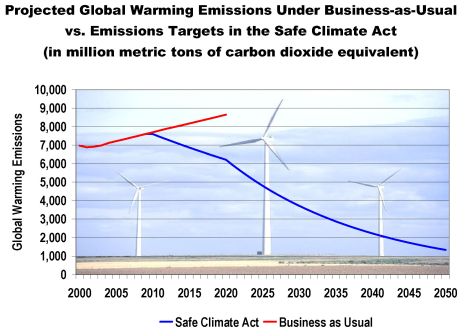
For weeks now, I’ve had an open tab in Firefox with Rep. Henry Waxman’s Safe Climate Act languishing in it, waiting for my loving bloggy ministrations.
Today, I finally had a look, and Ana’s right — this is a more powerful and more sensible plan that the one Kerry described yesterday. The main reason, in my view, is not so much the stronger ultimate target (80% vs. 65% below 2000 emissions by the year 2050) but the incrementalism — precisely the problem ffletcher identified. Here’s the capsule version of the plan:
- Science tells us that we face a grave risk of irreversible and devastating global warming if global temperatures increase by more than 3.6°F.
- The bill sets greenhouse gas emissions targets that aim to keep temperatures below the danger point. The level of emissions is frozen in 2010 and then gradually reduced each year through 2050.
- The bill achieves these targets through a flexible economy-wide cap-and-trade program for greenhouse gas emissions, along with measures to advance technology and reduce emissions through renewable energy, energy efficiency, and cleaner cars.
Here’s how the targets will work:
The Safe Climate Act (H.R. 5642) freezes U.S. greenhouse gas emissions in 2010, at the 2009 levels. Beginning in 2011, it cuts emissions by roughly 2% per year, reaching 1990 emissions levels by 2020.& After 2020, it cuts emissions by roughly 5% per year. By 2050, emissions will be 80% lower than in 1990.

The great benefit of incremental targets — as aptly described in this Worldchanging post — is that they are predictable. They call for steady work and stable programs; they allow no procrastination and last-minute band-aids.
As Matt Stoller says, Waxman seems to have really bright people on his staff. Kerry’s speech and his plan have a bit of posturing and showmanship about them, but Waxman’s is carefully and structurally sound, down to the details (check out the stuff about national energy-efficiency and renewable-energy standards). You can read a detailed description of the plan here or the full text here (PDF). I also highly recommend Waxman’s statement.
What needs to happen next is for a Democrat to introduce the bill in the Senate. Someone looking to make this a defining issue in their political life. Obama?
(Or, wait! Now that we have this sensible plan on the table, maybe the key is to start up a third party to magically get it passed!)


